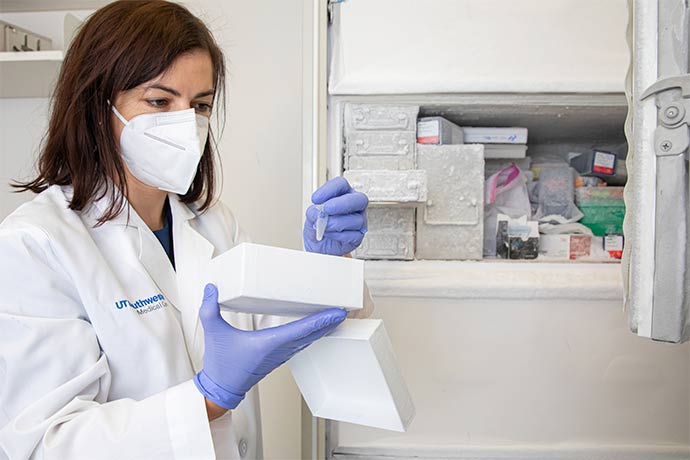President’s Lecture Series: New technology lets researchers identify the genes inside an individual brain cell

Scientists today have tools that allow them to break open a human cell and count the number and types of genetic molecules inside. The technique, called single-cell genomics, and its promise for furthering our understanding of the human brain, will be the focus of an April 28 President’s Lecture by Genevieve Konopka, Ph.D.
Dr. Konopka, Associate Professor of Neuroscience and a member of the Peter O’Donnell Jr. Brain Institute, will speak at 4 p.m. in the Tom and Lula Gooch Auditorium, with a reception to follow.
Her lecture, “What Makes Us Human? Exploring Brain Cells One at a Time,” will also appear online during the event and be posted afterward. The presentation will be available at utsouthwestern.edu/pls.
The human brain is home to about 170 billion individual cells – on the same order as the number of stars in the Milky Way (estimated at 100 billion to 400 billion), Dr. Konopka said. Until about 10 years ago, the only way to determine the types and quantity of DNA and RNA inside these cells in order to study variations in genes and their actions was to take a section of donated brain tissue, grind it up, and then measure the DNA and RNA molecules in the entire specimen, she said.
But that is a blunt tool that cannot tell a researcher what is happening inside a specific brain cell, she said. To find and target treatments for brain diseases such as autism, Alzheimer’s, and schizophrenia, scientists need to know what genes and which specific areas of the brain are involved, Dr. Konopka explained. Single-cell genomics allows researchers to peer down to that cellular level.
Here’s how it’s done: First, detergents are used to break a tissue sample into its individual cells, Dr. Konopka said. Then, using a microfluidics device that can manipulate very small amounts of fluid, each cell is encapsulated in a tiny bead or droplet that contains nucleotides and reagents that will lyse, or break apart, the cell into its different components – DNA and RNA molecules, among others – that spill out and are contained inside the bead. The researcher can then use a different instrument, called a DNA sequencer, to identify and quantify the amount and types of genetic DNA and RNA molecules inside a specific cell.
“Basically, you take a complicated tissue like the brain, comprised of hundreds of cell types, and you disassociate it into individual cells. And then you push each individual cell through a device that encapsulates one cell at a time into a microbead,” Dr. Konopka said. Once that is done and the various molecules and genes are separated, researchers can identify what types and how much DNA and RNA is inside a cell.
Dr. Konopka came to UT Southwestern as an Assistant Professor of Neuroscience in 2011 after receiving a Bachelor of Science in both biology and brain and cognitive sciences from the Massachusetts Institute of Technology and a Ph.D. in neurobiology from Harvard University.
In her lab at UT Southwestern, she works to identify the genes most important for human brain evolution and human cognition. Dr. Konopka also searches for the specific genes involved in diseases such as autism and schizophrenia in an effort to understand the role those genes play in directing brain development and function.

She is known for her work on a gene family tied to human speech and language as well as to autism, the FOXP genes. In addition, Dr. Konopka was senior author of a 2019 paper in PNAS that highlighted the role in human brain evolution of oligodendrocytes, the cells that produce a protective sheath around neurons in the brain and spinal cord.
In a 2021 study searching for genes tied to memory, published in Nature Neuroscience, Dr. Konopka examined brain tissue surgically removed from epilepsy patients during treatment to identify cell types and genes in areas that were activated during earlier memory tests. The research found 300 genes that appear to be tied to memory, in particular one known as SMAD3, a gene that had previously been linked to memory processing in data from non-epileptic individuals as well.
It will probably be another 20 years before such brain cell findings can be turned into treatments or individualized medicine for patients, Dr. Konopka said. But she is optimistic about the ultimate impact of single-cell genomics research.
“The findings made possible with single-cell genomics are going to intersect with pharmaceutical development, I hope, and viral gene therapies,” she said. “I’m amazed at how fast things have developed. Twenty years ago, scientists had just completed sequencing the human genome.”
Dr. Konopka holds the Townsend Distinguished Chair in Research on Autism Spectrum Disorders and is a Jon Heighten Scholar in Autism Research.

